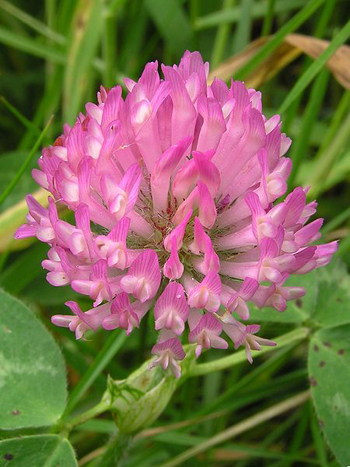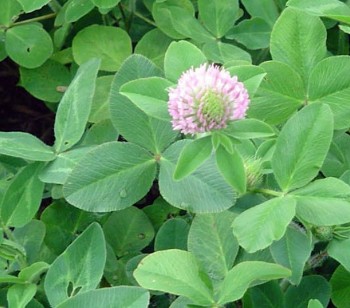Contents:
Common Names | Parts Usually Used | Plant(s) & Culture | Where Found | Medicinal Properties | Biochemical Information
Legends, Myths and Stories | Uses | Formulas or Dosages | Nutrient Content | How Sold | Warning | Resource Links | Bibliography
Scientific Names

- Trifolium pratense L.
- Leguminosae
- Pea family
Common Names
- Cleaver grass
- Cow grass
- Marl grass
- Purple clover
- Trefoil
- Vana-methika (Sanskrit name)
- Wild clover
Parts Usually Used
Flowers
Back to Top
Description of Plant(s) and Culture
Wild or red clover is a perennial plant; its short rootstock produces several reddish stems, 1-2 feet high, with close-pressed whitish hairs. The palmate leaves, some basal and come along the stems, have 3 oval to oblong-oval or obovate leaflets which are minutely toothed and sometimes blotched with white. The rose-purple or magenta (to nearly white in some varieties) flowers grow in a dense, ovoid head subtended by a leaf. May to September.
Back to Top
Where Found
Common in meadows, fields, on lawn edges, and roadsides all over North America and Europe.
Back to Top
Medicinal Properties
Diuretic, expectorant, antispasmodic, alterative, anti-tumor, mild stimulant
Back to Top
Biochemical Information
Biotin, choline, copper, coumarins, glycosides, inositol, magnesium, manganese, selenium, vitamins A, B1, B2, B3, B5, B6, B12, C, and P, and zinc.
Back to Top
Legends, Myths and Stories

Clover, one of the first plants cultivated by man, has been highly regarded since ancient times. The three-leaf clover was associated with the Christian Trinity, and in pre-Christian eras with the triad goddesses of the Celts. The Middle Ages considered clover a charm against witches. Wood sorrel (Oxalis acetosella) is considered by some authorities to be the true shamrock planted by St. Patrick in Ireland, instead of clover.
The rare four-leaf clover, also a Christian symbol representing the cross, was said to enable its wearer to ward off evil and witches, to see fairies and various spirits, to heal illnesses, to have good fortune, and to escape military service. One leaf stood for fame; the second, wealth; the third for a faithful lover; the fourth for good health. The five-leaf clover was said to be unlucky and the two-leaf clover was to enable a maid to see her future lover.
Back to Top
Uses
A sweet herb that is a blood purifier, and antibiotic used for tuberculosis and to fight other bacteria. A relaxant, an appetite suppressant. Good for inflamed lungs, colds, flu, cough, fever, whooping cough, and other inflammatory conditions related to gout and arthritis, most glandular ailments, gastric trouble, skin disorders, headaches, neuralgia, and the AIDS virus. Has positive effects on cancer patients when taken with chaparral. A syrupy extract of the flowers can be used externally for persistent sores, burns, abscesses, fever sores, and ulcers, also believed to prevent cancer or arrest tumors. A poultice of the plant can be tried for athlete’s foot and other skin problems. The flowers were formerly smoked in anti-asthma cigarettes. Science has not confirmed traditional uses, though the plant contains many biologically active compounds, including estrogen.
Back to Top
Formulas or Dosages
The flower heads should be eaten raw (about a dozen daily), or dried and made into an infusion.
Infusion: steep 2 tsp. flowering tops in 1/2 cup water for 10 minutes. Take 1 to 1 1/2 cups a day, with or without honey, a mouthful at a time.
Tincture: a dose is from 5-30 drops, taken in water.
Back to Top
Nutrient Content
Vitamins A, B1, B2, B3, B5, B6, B12, C, and P, and zinc.
Back to Top
How Sold
Capsules: take one, 2 or 3 times a day.
Back to Top
Warning
Fall or late-cut hay in large quantities can cause frothing, diarrhea, dermatitis, and decreased milk production in cattle. Diseased clover, externally showing no symptoms, may contain the indolizidine alkaloid slaframine, which is much more poisonous than castanospermine, now being studied for anti-AIDS and antidiabetic activity.
Back to Top
Resource Links
LiveStrong.com: Information on Red Clover Blossoms & Herbs
LiveStrong.com: Red Clover Dangers
LiveStrong.com: Thistle & Clover
LiveStrong.com: Red Clover & Hot Flashes
University of Maryland Medical Center: Red Clover
Memorial Sloan-Kettering Cancer Center: Red Clover
National Center for Complementary & Alternative Medicine: Red Clover
PubMed.gov: Treatment strategies for reducing the burden of menopause-associated vasomotor symptoms.
Bibliography
![]() The Herb Book
The Herb Book, by John Lust, Bantam Books, 666 Fifth Avenue, New York, NY. copyright 1974.
![]() Back to Eden
Back to Eden, by Jethro Kloss; Back to Eden Publishing Co., Loma Linda, CA 92354, Original copyright 1939, revised edition 1994
![]() Chinese Medicinal Herbs
Chinese Medicinal Herbs, compiled by Shih-Chen Li, Georgetown Press, San Francisco, California, 1973.
![]() The Herbalist Almanac
The Herbalist Almanac, by Clarence Meyer, Meyerbooks, publisher, PO Box 427, Glenwood, Illinois 60425, copyright 1988, fifth printing, 1994
![]() Eastern/Central Medicinal Plants
Eastern/Central Medicinal Plants, by Steven Foster and James A. Duke., Houghton Mifflin Company, 215 Park Avenue South, New York, NY 10000
 The Magic of Herbs
The Magic of Herbs, by David Conway, published by Jonathan Cape, Thirty Bedford Square, London, England. (Out of print)
![]() Planetary Herbology
Planetary Herbology, by Michael Tierra, C.A., N.D., O.M.D., Lotus Press, PO Box 325, Twin Lakes. WI 53181., Copyright 1988, published 1992
![]() The Complete Medicinal Herbal
The Complete Medicinal Herbal, by Penelope Ody, Dorling Kindersley, Inc, 232 Madison Avenue, New York, NY 10016, First American Edition, copyright 1993
![]() Indian Herbalogy of North America
Indian Herbalogy of North America, by Alma R. Hutchens, Shambala Publications, Inc., Horticultural Hall, 300 Massachusetts Avenue, Boston, Massachusetts 02115, 1973
![]() Indian Uses of Native Plants
Indian Uses of Native Plants, by Edith Van Allen Murphey, Meyerbooks, publisher, PO Box 427, Glenwood, Illinois 60425, copyright 1958, print 1990
![]() American Folk Medicine
American Folk Medicine, by Clarence Meyer, Meyerbooks, publisher, PO Box 427, Glenwood, Illinois 60425, 1973
![]() Prescription for Nutritional Healing, Fifth Edition: A Practical A-to-Z Reference to Drug-Free Remedies Using Vitamins, Minerals, Herbs & Food Supplements
Prescription for Nutritional Healing, Fifth Edition: A Practical A-to-Z Reference to Drug-Free Remedies Using Vitamins, Minerals, Herbs & Food Supplements, by James F. Balch, M.D. and Phyllis A. Balch, C.N.C., Avery Publishing Group, Inc., Garden City Park, NY
![]() Webster’s New World Dictionary
Webster’s New World Dictionary, Third College Edition, Victoria Neufeldt, Editor in Chief, New World Dictionaries: A Division of Simon & Schuster, Inc., 15 Columbus Circle, New York, NY 10023
 The Magic of Herbs in Daily Living
The Magic of Herbs in Daily Living, by Richard Lucas, Parker Publishing Co. (1988).
 A Useful Guide to Herbal Health Care
A Useful Guide to Herbal Health Care, HCBL (Health Center for Better Living).,1414 Rosemary Lane, Naples, FL 34103., Special Sale Catalog, 1996
![]() The Yoga of Herbs: An Ayurvedic Guide to Herbal Medicine
The Yoga of Herbs: An Ayurvedic Guide to Herbal Medicine, by Dr. David Frawley & Dr. Vasant Lad, Lotus Press, Twin Lakes, Wisconsin, Second edition, 1988.
 The Rodale Herb Book: How to Use, Grow, and Buy Nature’s Miracle Plants (An Organic gardening and farming book)
The Rodale Herb Book: How to Use, Grow, and Buy Nature’s Miracle Plants (An Organic gardening and farming book), edited by William H. Hylton, Rodale Press, Inc. Emmaus, PA, 18049., 1974
